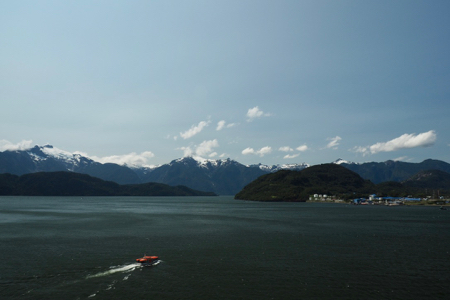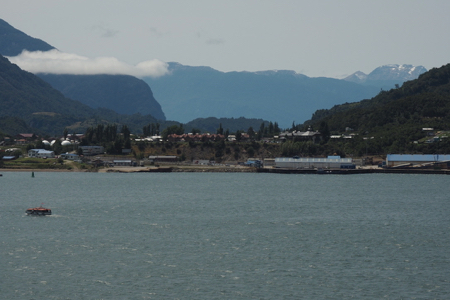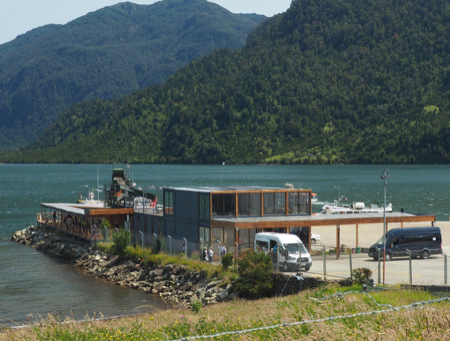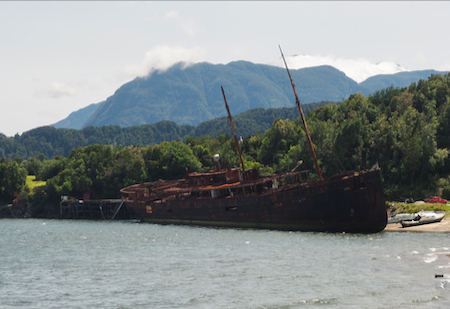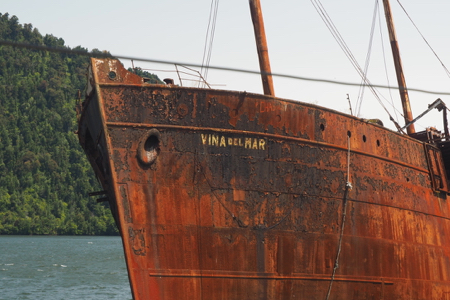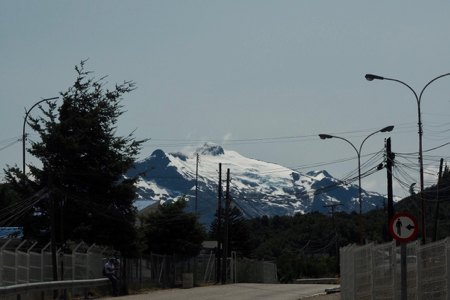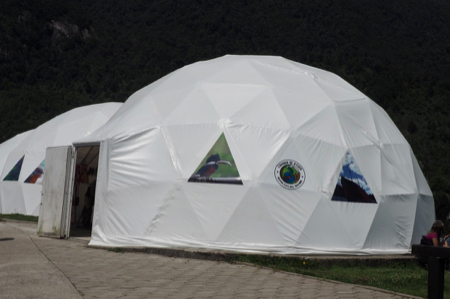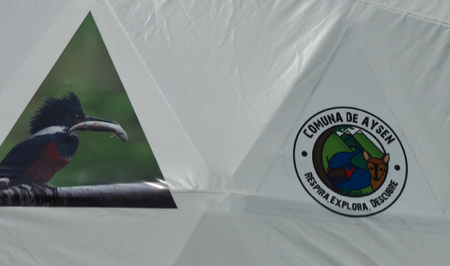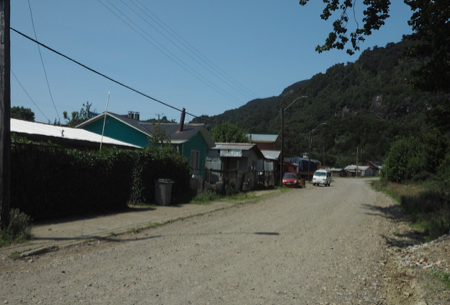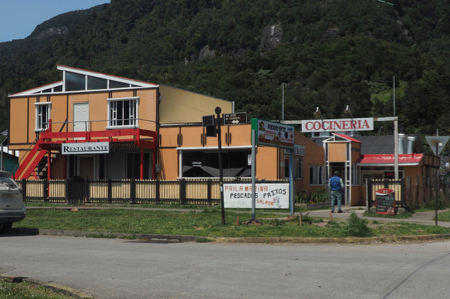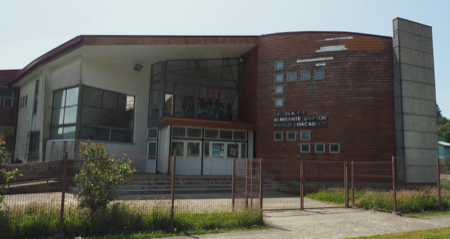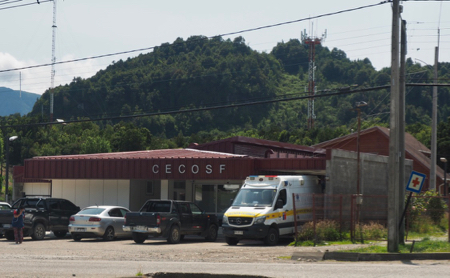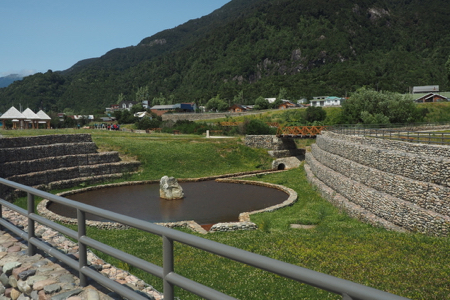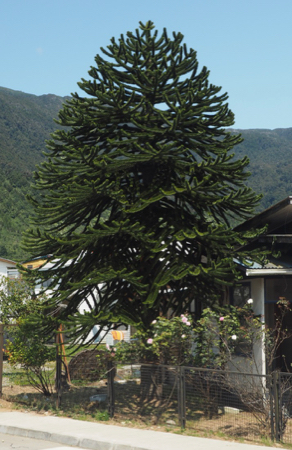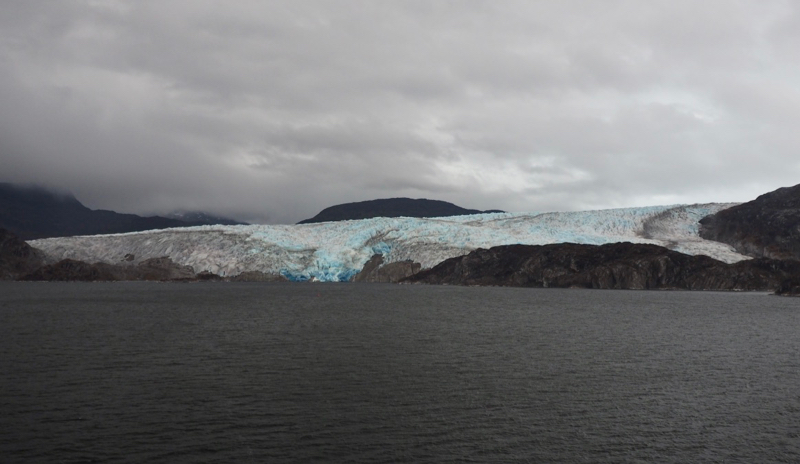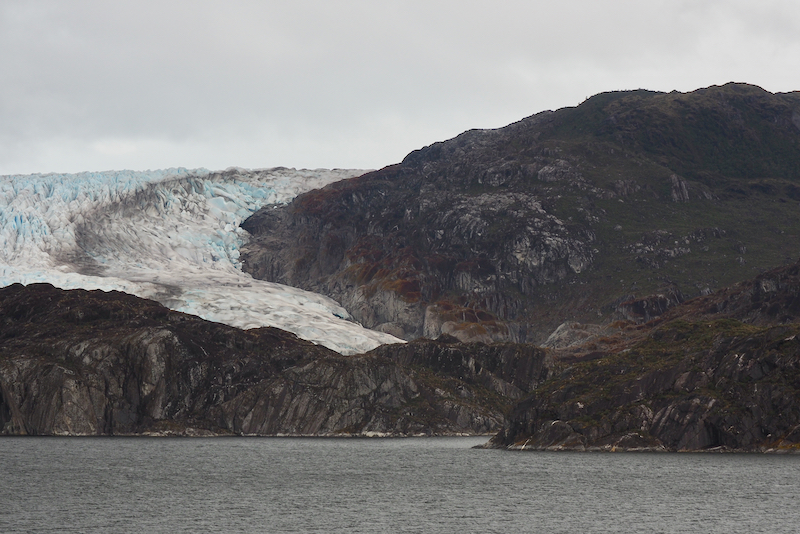We sailed beyond Castro last night so we are now on the part of our cruise that we missed last year. This morning the Zaandam anchored off Puerto Chacabuco, a very small fishing village, but one that evidently accepts cruise ships. After lunch we tendered into the dock and walked around the town - that's all there is to do in the town. All of the HAL excursions involved at least an hour-long bus ride or more to a national park to see a waterfall or a lake.
Scenic bay
The town
"Cruise terminal"
There was free Wi-Fi in the “passenger terminal,” a derelict trawler aground at one end of town, and a small fishing boat operation at the other end. The distance between them was no more than one-quarter-mile. We walked both ways, then up hill to three small canvas dome tents where women were selling handicrafts - mostly knitted or crocheted items.
Further strolling took us away from the dock and past the school and “hospital.” Thank goodness Marge did not end up here last year! There is a very nice newly constructed common area and playground. The entire walk through the town took less than an hour.
Derelict trawler
Derelict trawler
Derelict trawler
More scenery
Domed tents for handicraft sales - nice kingfisher with fish
Street scene
Restaurant
Pretty little house and garden
Satellite dish nearly perpendicular to the ground and facing north - DirectTV gets around
School
Medical center - thank heaven I didn't end up here last year!
New park
For the kids
Monkey Puzzle tree
Fish farming
Since this was a sea day, the "Expedition Team" began presenting informative lectures on Antarctica: “Short History of Antarctic Exploration”and “Antarctica: A Frozen Continent” were the first offerings.
A few interesting facts: East Antarctica and West Antarctica are divided by the Trans Antarctica Mountain Range; the Ross and Filchner-Ronne “ice sheets” are actually Ice Shelves because they float over water, in large bays in this case; Ice caps or Ice sheets cover ground; Fast Ice is sea ice that attaches to the edge of an ice shelf. On April 13, 2000 a huge piece of the Ross Ice Shelf broke loose. It was approximately 170 by 20 miles large. Most of Antarctica’s “ground” is below sea level because of the weight of the ice sitting on top of it. In 1959, the Antarctic Treaty was signed by the 12 countries engaged in research in the Antarctic. The purpose of the treaty was/is to retain Antarctica for “peace and science.” Currently, 54 countries have signed the treaty. No country “owns” Antarctica or any part of it, although several countries have planted flags on sections of it. Twenty-nine countries are actively doing research on Antarctica.
The South Pole lies at an elevation of 9,301 feet and the ice there is 9,000 feet deep. The average temperature is -56°F. More than 20,000 meteors have been found on Antarctica. They are easy to spot in the white snow and ice. Mt. Kirkpatrick is the highest mountain at about 15,000 feet.
At 4:30 our ship entered an inside passage to pass by the Tempanos Glacier. It poured rain briefly and then the cloud passed on. This tidal glacier has receded so much it will soon become a terminal glacier - one that ends on land. The crevasses were very dark blue in the cloudy light.
Tempanos Glacier
Tempanos Glacier
Wed., 1/15 - At Sea - Scenic Cruising in the Chilean Fjords
Three more lectures during this day of cruising the inner passage through the Patagonian fjords. Dr. Torre Stockard, an American marine biology PhD spoke on “The Pulse of Antarctica.” She explained that even though Antarctica is the coldest (average -56°F at the SP and -128.6° F the coldest record on the continent), the driest, windiest (60 MPH average sustained wind) and most isolated continent, there is still life here that is able to adapt and survive. There are plants like moss, lichen, Antarctica hair grass and Antarctica pearl wort. There are phytoplankton in the sea, 200 plankton types that feed the Antarctic krill that feed the whales, seals, and penguins. The krill larvae feed on algae that grow on the undersurface of sea ice. There are birds: petrels and albatross that only come to land to nest; terns, skuas, and penguins (Emperor, Adelie, Gentoo, and Chinstrap). There are mammals: seals (elephant, fur, leopard, crab eaters, Ross, and Weddell) and whales (Blue, humpback, Southern right, orca, and minke). The Antarctica sea current and the polar winds move clockwise around the continent.
At 11:30, Kevin, the cruise director, spoke about Patagonia which is the southern region of South America with 90% belonging to Argentina and 10% to Chile. He spoke about Indigenous people killed off by the Argentine government, the variety of landscapes, the desert and mountains, cities and national parks. We have visited several of the places he talked about. Kevin spoke a little about Mr. Benetton and his “United colors of Benetton land grab.” He bought up more than 900,000 acres of Patagonia, chased off or killed all of the native Mapuche, and ran sheep, millions of them, over the steppes to raise the wool for the Benetton brand. This has led to boycotts of the Benetton brand. The Patagonia Company, also a large land holder raising sheep in Patagonia, used to give profits back to Patagonia but more recently are using profits for ecology in the US.
At 2:30 Dr. Craig Cormick spoke about “Ernest Shackleton, the Man behind the Myth.” Shackleton attempted four Antarctica expeditions between 1901 and 1921. The one in 1914 - 1917 was the disaster and the book “South” tells the struggle to be rescued after sea ice locked in his ship which eventually sank.
At 6 PM we went to a complimentary sampling of Amarula liquor at the Shops Onboard. It is one of our favorites. This we used to celebrate our passing over a shoal in the fjords that gave us 8 feet of depth instead of the 3 feet of clearance that was predicted at high tide. The captain slowed us to 6 knots so the ship would not “squat” any deeper in the water.
| Return to Top | Return to Itinerary | Return to Trips page to view other trips | Return to Dreamcatcher Home Page |

